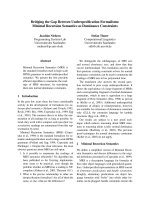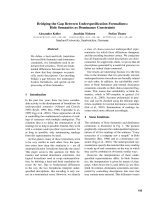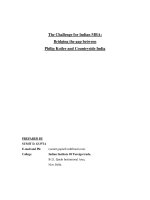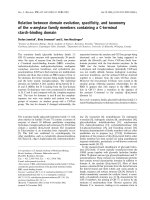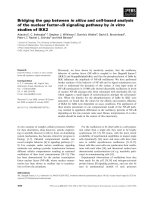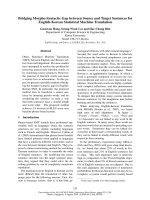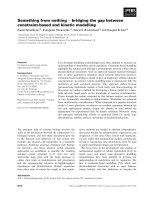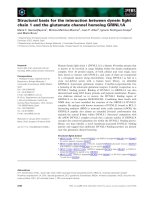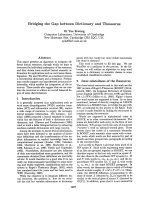Smart home for elderly: Exploring gap between existing home communication system and needs of elderly
Bạn đang xem bản rút gọn của tài liệu. Xem và tải ngay bản đầy đủ của tài liệu tại đây (249.33 KB, 7 trang )
Int.J.Curr.Microbiol.App.Sci (2020) 9(8): 2152-2158
International Journal of Current Microbiology and Applied Sciences
ISSN: 2319-7706 Volume 9 Number 8 (2020)
Journal homepage:
Original Research Article
/>
Smart Home for Elderly: Exploring Gap between Existing Home
Communication System and Needs of Elderly
R. Unesha Fareq* and T. Neeraja
Department of Family Resource Management, APGC, Acharya N.G. Ranga Agricultural
University, Lam-522034, Guntur, Andhra Pradesh, India
*Corresponding author
ABSTRACT
Keywords
Home communication
system, Ageing in
place, Elderly people,
Existing home
communication
systems, Needs of
elderly, Standard
guidelines of home
communication
system
Article Info
Accepted:
20 July 2020
Available Online:
10 August 2020
Ageing in place can be defined as the tendency of elderly people to live independently in
their own house. The desires to live independently during old age throw challenge to
interior designers to think up suitable dwelling that facilitate elderly to age in place. The
present research aimed at identifying the gap between existing home communication
system and housing needs of elderly. The elderly women in the age of sixty and above
who were able to carry out their daily chores were selected as sample. The sample was
drawn from Kurnool district of Andhra Pradesh. The standard design guidelines evolved
through research by various Government and Non-government organizations and
researchers served as a yardstick to identify the existing features and needs of elderly
people. The results revealed that families with high monthly income and who are living in
relatively big houses were found with advanced home communication system. The elderly
felt essential to provide a house with all the required home communication system which
are elderly friendly and easy to operate. The highly significant chi-square value revealed a
strong evidence against the null hypothesis. Hence there exists an association between the
existing home communication system and the needs of the respondents to age in place.
Home communication devices were not popular among existing houses under the study.
Introduction
The term Home communication systems
refers to the devices that allow the people to
communicate using audio visual aids from
various spaces in the home without direct
interaction. These devices are going to be
very familiar technology that will be adopted
in the near future while designing both
residential and commercial interiors to ensure
comfortability and safety. Ageing population
and advancement of modern smart
technologies are mutually playing a crucial
role in both developing and developed
countries for providing services to the elderly
people to age in place (Bostjan, 2018). Smart
homes with required communication systems
and healthcare facilities can allow the elderly
2152
Int.J.Curr.Microbiol.App.Sci (2020) 9(8): 2152-2158
people to stay in their home environments
comfortably (Sumit et al., 2017). The
limitations in the design features of
equipment and furniture provided in the
elderly houses leads to the situation in which
elderly people have to dependent on any
support system to perform their activities in
the home. For this reason, it is essential to
take into consideration the housing needs of
the elderly and accommodate the elderly
home with ergonomically designed equipment
and enable them to lead their life
independently, comfortably and age in place
Hence the study was aimed to identify the gap
between existing home communication
system and needs of the elderly.
Materials and Methods
The study was conducted in the Kurnool
district of Andhra Pradesh. Expost-facto
research design was followed for the study.
Random sampling method was adopted to
select the locations to draw the sample.
Purposive sampling technique was adopted to
draw the sample from the randomly selected
study locations. A total of 60 elderly women
in the age of sixty and above who were able
to carry out their daily chores independently
and living in a separate dwelling without
children with or without spouse was the
criteria for the selection of sample. The
standard design guidelines evolved through
research by various Government and Nongovernment organizations and researchers
served as a yardstick to identify the existing
features and needs of elderly people. The data
was collected through structured interview
cum observation schedule. The socio
economic scale “Modified Kuppuswamy
scale updated for year 2018” by Saleem
(2018) was adopted to study the
socioeconomic status of the respondent. The
houses of the elderly selected for the present
study were physically observed and gathered
the information on provisions made in the
housing and assessed in terms of scores 3,2
and 1 for „above the recommended
guidelines‟, „exactly as per the recommended
guidelines‟ and „below the recommended
guidelines‟. The respondents were asked to
state their recommendations for provision of
home communication system to enable them
to live comfortably and independently in old
age keeping in view of their limitations. The
requirements of the elderly were categorized
as „essential‟, „preferred‟ and „neutral‟ with
scores 3, 2 and 1 respectively.
Frequencies and percentages were calculated
for the existing home communication system
and needs of the respondents. Chi square
analysis was done to find out the gap between
existing home communication system and
needs of the respondent.
Standard design guidelines for home
communication system
Guidelines
for
provision
of
Home
communication systems in the home were
gathered through literature survey. Seventeen
features that enable the elderly to use the
home communication system without any
discomfort were identified from the
guidelines for home communication system
which served as a base for identifying the
features
to
measure
the
existing
communicating systems in the house.
Provision of an automatic fire alarm system,
telephone near the bed with large keys,
videophone connection in the home and
placement of alarm pull cord in the bathroom
at a height easily reached by someone lying
down were recommended in the elderly
housing to ensure safety for elderly people
(Welfare housing policies for senior citizens,
2007). Provision of emergency alarm system,
automatic remote opening doors, electric fuse
boxes with automatic circuit breakers and gas
leak detection systems were suggested in
2153
Int.J.Curr.Microbiol.App.Sci (2020) 9(8): 2152-2158
elderly house (Parker, 1987; Welfare housing
policies for senior citizens, 2007, Model
guidelines for development and regulation of
retirement homes, 2019).
Results and Discussion
Background
respondents
information
of
the
Most of the elderly women were found
educated. Nearly one third of the women born
between 1955 and 1965 were found with
graduation level of education. Families in
their contracting stage of life were found
earning neither too high nor too low. Most of
them were with sufficient income to live
comfortably. The most popular types of
houses found were Independent houses,
Independent
double
storied
houses,
Apartments or flats and Duplex type of
houses. The apartment culture was gaining
popularity in recent times. The desire to own
a house when started life as young couple was
fulfilled by majority of the elderly. The
houses the elderly residing were not new
houses. The elderly might have owned houses
and continued their stay in the same houses.
Most of the elderly families were found to be
in upper middle income category. This
generation of families in the contracting stage
of family life was found financially,
comfortable.
Existing home communication systems in
the house of elderly
Two thirds of the houses were provided with
telephone with light indicator (35%) that was
easily visible and audible within the home.
No house was provided with alarm pull cord
at bathroom and remotely operated doors in
the home. Half of the houses had opening
system on the doors which required only one
single type of key. Majority (96%) of the
houses were well ventilated in a natural way.
More than two thirds of the houses had sound
proof waste ducts and pipes to limit annoying
noises in the rooms where it was provided.
Maximum houses didn‟t have gas leak
detection systems, smoke alarm systems for
emergency, burglar proof door, safety and
monitoring systems. Ninety-three per cent of
the houses had illuminated front door bell.
Sixty-eight per cent of the houses had fuse
box with automatic circuit breakers. The
results were presented in Table 1.
Needs of elderly with reference to home
communication system
Half of the respondents felt essential to
provide telephone with large easy to read keys
for most used numbers. Thirty-one per cent of
the respondents felt essential to have alarm
pull cord at bathroom at a height easily
reached by someone lying down. More than
half (55%) of the elderly felt neutral to have
opening system on the doors which required
only one single type of key. Forty-six per cent
of the elderly felt essential to have ventilation
for the houses in a natural way. Majority
(81%) of the respondents felt neutral to have
sound proof waste ducts and pipes to limit
annoying noises in the rooms. Seventy-eight
per cent of the elderly felt essential to have
burglar proof doors. More than half (63%) of
the elderly felt essential to have gas leak
detection systems with remote alarms.
Majority (86 %) of the respondents expressed
neutral opinion towards the need for
emergency alarms, light controls at bed side
and also at toilet seat in bathrooms, provision
of smoke or file alarm system with remote
response facility. The results were presented
in Table 2.
Association
between
existing
home
communication system and needs of the
elderly
Chi square analysis was done to find out the
association
between
existing
home
communication system and needs of the
2154
Int.J.Curr.Microbiol.App.Sci (2020) 9(8): 2152-2158
respondent. The null hypothesis formulated
was
H0 There exists no significant association
between existing home communication
system conditions and needs of elderly with
reference to home communication system
to age in place
More than half of the respondents (55 %)
preferred to have home communication
system as per the guidelines. The
recommended
guidelines
for
home
communication system in the house were
provision of various communication systems
in various room to assist the elderly in an easy
way.
The highly significant Chi-square value
revealed a strong evidence against the ull
hypothesis. Elderly respondents preferred
provision of safety devices. The results of the
study are in line with the study conducted by
Jaspers (2017) wherein it was found that the
provision of emergency alarm systems were
preferred by the elderly (Table 3).
There exists an association between the
existing home communication system and the
needs of the respondents to age in place with
reference to home communication system.
Hence, null hypothesis was rejected.
Table.1 Distribution of respondents by existing home communication design features
n=60
Recommended
Status of existing design features against the Total
Design guidelines
guidelines
Above
the Exactly as per Below
the
recommended the
recommended
guidelines
recommended
guidelines
guidelines
N
%
N
%
N
%
N
%
66.67 0
0
20
33.33
60 100
A telephone with large easy 40
to read keys for preferred
numbers was present
35
0
0
39
65
60 100
Telephone with a light 21
indicator easily visible and
audible within the home was
present
0
0
0
60
100
60 100
Placed the alarm pull cord in 0
the bathroom at a height
easily reached by someone
lying down. The alarm
system was connected to a
reset button
0
0
0
60
100
60 100
An opening system for the 0
entrance door to the building
which can be remotely
operated from inside the
home was present
50
0
0
30
50
60 100
An opening system on the 30
2155
Int.J.Curr.Microbiol.App.Sci (2020) 9(8): 2152-2158
doors which requires only
one single type of key was
provided
An automatic or manual
thermostat in the home
which
was
remotely
regulated was provided
The
home
was
well
ventilated in a natural way
Sound proof waste ducts and
pipes to limit annoying
noises in the bedroom and
living room were provided
For homes on the ground
floor safety systems on all
external doors and windows
were installed
For homes on higher floors
safety systems (or alarms) on
windows and any balcony
doors were installed
A video system for tele
assistance or a personal
alarm system which allows
for remote warning was
provided
Provided an illuminated
front door bell
Burglar proof front doors
were provided
Fuse boxes had automatic
circuit breakers
Gas leak detection systems
with remote alarms were
provided
Installed smoke/fire alarm
systems which also had
remote response facility
Emergency alarms and light
controls at bedside and
bathrooms near toilet seat
were provided
0
0
0
0
60
100
60
100
58
96.67
0
0
2
3.33
60
100
41
68.33
0
0
19
31.67
60
100
1
1.67
0
0
59
98.33
60
100
0
0
0
0
60
100
60
100
0
0
0
0
60
100
60
100
56
93.33
0
0
4
6.67
60
100
0
0
0
0
60
100
60
100
41
68.33
0
0
19
31.67
60
100
0
0
0
0
60
100
60
100
0
0
0
0
60
100
60
100
0
0
0
0
60
100
60
100
2156
Int.J.Curr.Microbiol.App.Sci (2020) 9(8): 2152-2158
Table.2 Distribution of respondents by their needs in designing a home communication system
n=60
Housing needs of the elderly
Adequacy of housing needs
Total
Essential
Preferred
Neutral
N
%
N
%
N
%
N %
30
50
15
25
15
25
60 100
A telephone with large easy to read keys
for most used numbers
15
32
53.33 60 100
Provision of alarm pull cord connected 19 31.67 9
with reset button in the bathroom at a
height easily reached by someone lying
down.
0
27
45
33
55
60 100
An opening system for the entrance door 0
to the building which can be remotely
operated from inside the home
0
6
10
54
90
60 100
An automatic or manual thermostat in the 0
home which is remotely regulated
28 46.67 11
18.33 21
35
60 100
The home ventilated in a natural way
0
11
18.33 49
81.67 60 100
Sound proof waste ducts and pipes to 0
limit annoying noises in the bedroom and
living room
47 78.33 11
18.33 2
3.33 60 100
Burglar proof front doors
38 63.33 7
11.67 15
25
60 100
Fuse boxes with automatic circuit
breakers
1
1.67
8
13.33 51
85
60 100
Gas leak detection systems with remote
alarms
0
11
18.33 49
81.67 60 100
Smoke/fire alarm systems which also have 0
remote response facility
0
8
13.33 52
86.67 60 100
Emergency alarms and light controls at 0
bedside and bathrooms near toilet seat
Table.3 Association between existing home communication system and needs of the elderly
n=60
Existing home communication
Design needs with reference to
system
home communication system
Neutral
Preferred
Total
N
%
N
%
N
%
14
23.33
13
21.67
27
45.00
Below the recommended guidelines
1
1.67
32
53.33
33
55.00
Exactly as per the recommended
guidelines
15
25.00
45
75.00
60
100.00
Total
2
ꭓ value
18.8777
Probability value
<.0001*
Note- *- significant at 1 per cent level
2157
Int.J.Curr.Microbiol.App.Sci (2020) 9(8): 2152-2158
In
conclusion,
advanced
home
communication design features such as alarm
pull cord in the bathroom at a height easily
reached by someone lying down, an opening
system for the entrance door to the building
which can be remotely operated from inside
the home, an automatic or manual thermostat
which can be remotely regulated , gas leak
detection systems with remote alarms,
smoke/fire alarm systems, emergency alarms
and light controls at bedside and bathrooms
near toilet seat were not found in all most all
of the houses.
Telephone with large easy to read keys, an
opening system on the doors which requires
only one single type of key, sound proof
waste ducts and pipes to limit annoying noises
were some of the design features provided in
existing houses. Advanced communication
devices were not popular among existing
houses.
The elderly felt essential to provide a
telephone with large easy to read keys for
preferred numbers, an opening system on the
doors which requires only one single type of
key, sound proof waste ducts and pipes to
limit annoying noises, burglar proof front
doors, fuse boxes with automatic circuit
breakers.
References
Bostjan, K.2018.Using Information and
Communication Technology in Home
Care for the Elderly. In: Mukadder
Mollaoglu (ed.), Caregiving and Home
Care. Intech Open Limited, London,
UK.pp.205.
Jaspers, M.J.J.E. 2017. Housing Preferences
of an Ageing Population. M.Sc. Thesis.
Eindhoven University of Technology,
Netherlands.
Model Guidelines for Development and
Regulations of Retirement homes. 2019.
Ministry of Housing and Urban Affairs,
Government
of
India.
/>iles/Retirement%20Model%20Guidelin
es%20Book.pdf
Parker, W.R. 1987. Housing for the elderly.
In: J. DeChaira and J. Callender (eds.)
Time Saver Standards for Building
Types,
2nd
ed.
McGraw-hill
International Editions. pp. 87-101.
Saleem, S.M. 2018. Modified Kuppuswamy
scale updated for year 2018. ParipexIndian Journal of Research. 7(3):435436.
Welfare housing policies for senior citizens.
2007. Guidelines for the planning of
houses
for
senior
citizens. />_assets/Resources/Housing/Support_ma
terials/Other_reports_and_guidance/
Sumit, M., Emad, A., Moein, N., Hamidreza,
M., Tapas, M., Zhibo, P and Jamal D,
M.2017.Smart Homes for Elderly
Healthcare-Recent
Advances
and
Research Challenges. Sensors. 17(11):
2496.
How to cite this article:
Unesha Fareq, R. and Neeraja, T. 2020. Smart Home for Elderly: Exploring Gap between
Existing Home Communication System and Needs of Elderly. Int.J.Curr.Microbiol.App.Sci.
9(08): 2152-2158. doi: />
2158
